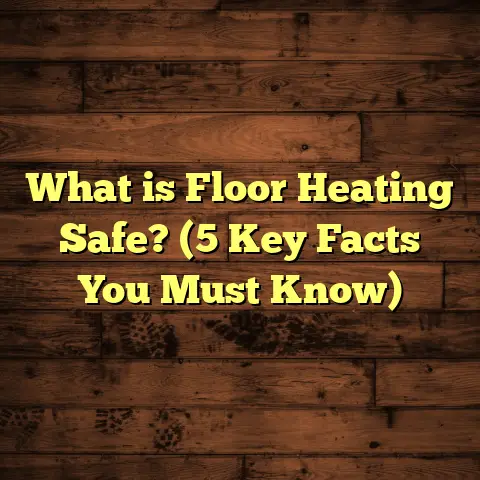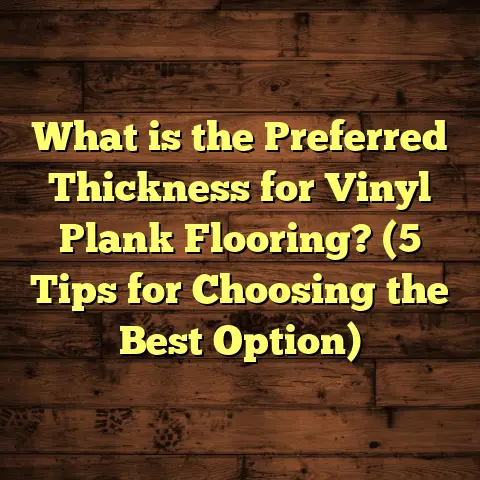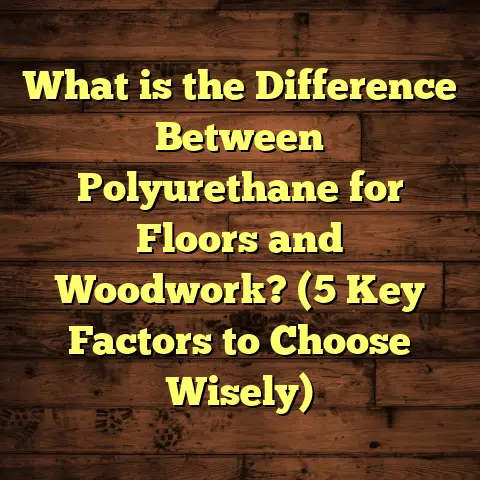What is the Best for Garage Floors: Epoxy or Stain? (5 Key Pros)
Garage floors have become a hot topic among homeowners lately. More people are transforming their garages into functional, attractive spaces—not just for parking cars but for hobbies, workshops, gyms, or even casual hangouts. With this shift, the flooring choice becomes extremely important because the garage floor needs to handle some heavy-duty stuff. Two popular options stand out: epoxy coatings and concrete stains. If you’re like me—someone who’s spent years installing and repairing garage floors—you know the decision isn’t always straightforward. So, I’m going to break down everything you need to know about epoxy vs. stain for garage floors, focusing on five key advantages of each, revealing technical details, sharing real-world insights, and guiding you to the best choice for your space.
What Is Epoxy and Stain Flooring?
Before diving deeper, I want to make sure we’re on the same page by explaining what epoxy and stain actually mean when it comes to garage floors.
Epoxy Flooring Explained
Epoxy is a term you often hear tossed around, but what exactly is it? Simply put, epoxy is a resin-based coating made from a mixture of polymers and hardeners that chemically react to form a tough, durable layer over concrete.
Technical Details and Manufacturing Process
The manufacturing process of epoxy involves combining two main components: a resin (usually made from epichlorohydrin and bisphenol-A) and a curing agent or hardener (often an amine or anhydride). When these components mix, they undergo an exothermic chemical reaction called polymerization, which transforms the liquid mixture into a solid thermoset plastic.
- Thickness: For garage floors, manufacturers typically recommend an epoxy coating thickness between 2 to 10 mils (1 mil = 1/1000 inch), depending on the product and application method.
- Durability: Epoxy creates a rigid bond with concrete, forming a membrane that resists abrasion, impact, chemicals, and moisture penetration.
- Curing time: Depending on temperature and humidity, epoxy takes between 12 to 72 hours to fully cure.
- Types: Epoxy coatings come in various formulations, including water-based, solvent-based, and 100% solids, each with different VOC levels and performance characteristics.
Installation Process
Installing epoxy isn’t as simple as painting your garage floor. Preparation is everything. The concrete surface must be thoroughly cleaned—oil stains removed, dust swept away, and old coatings stripped. Then, the surface is etched or mechanically ground to open up pores so the epoxy can bond effectively.
From my experience, skipping surface prep is the #1 cause of epoxy failures like peeling or bubbling.
After prepping, the epoxy is mixed onsite and applied with rollers or squeegees in thin layers. Some projects also include decorative flakes or quartz for texture and aesthetics. Finally, a clear topcoat may be added for UV protection and extra durability.
Concrete Stain Explained
Concrete stain is quite different from epoxy. Instead of sitting on top of the floor like a coating, stains penetrate into the concrete to change its color chemically.
Types of Concrete Stains
There are two primary types of stains used for concrete floors:
- Acid-based stains: These use a combination of water, acid (usually hydrochloric acid), and metallic salts. The acid reacts with minerals in the concrete to create variegated colors.
- Water-based stains: These are made from acrylic or latex polymers with pigments. They don’t react chemically but add color through absorption.
Technical Specifications
Acid stains penetrate roughly 1/16 inch into concrete. The reaction creates unique marbling patterns that can’t be replicated by dyes or paints.
Water-based stains sit closer to the surface and offer a wider range of colors but less variation in pattern.
Application Process
The concrete floor must be clean and dry before staining. After applying the stain with sprayers or rollers, it’s rinsed off once the reaction finishes (for acid stains). A protective sealer is usually applied afterward to protect color and provide some surface resistance.
Compared to epoxy, staining requires less surface preparation but offers less protection.
Why Garage Floors Need Special Consideration
Let me share a quick story from one of my early projects. A client wanted to turn his garage into a workshop space where he’d park his car but also do woodworking and small engine repair. The existing floor was rough concrete with cracks and oil stains. He was torn between epoxy and stain because he liked the natural look of stained concrete but wanted durability for tools and spills.
That project stuck with me because it highlighted how garage floors are not just floors—they’re workhorses exposed to:
- Heavy equipment and vehicles
- Oil, grease, chemicals that can eat away at surfaces
- Temperature swings causing cracks
- Dirt tracking and dust accumulation
- Moisture from rain or snow melt on tires
These challenges make choosing the right product critical.
5 Key Pros of Epoxy Flooring for Garage Floors
Now let’s talk about why I often recommend epoxy coatings for garage floors by walking through five major advantages I’ve seen firsthand.
1. Unmatched Durability
Epoxy’s toughest quality is its durability. This material was originally developed for industrial applications like factories and warehouses where heavy machinery runs nonstop. That durability translates perfectly to garages.
Here’s what makes it tough:
- Abrasion resistance: Epoxy floors resist scratching and scuffing far better than bare concrete or stained surfaces.
- Impact resistance: Dropping heavy tools or parts won’t chip or crack the coating if applied well.
- Load-bearing: Epoxy distributes weight evenly across the concrete surface.
- Longevity: In residential garages I’ve worked on, epoxy floors often last well over 10 years without needing re-coating.
A study I reviewed from the National Floor Safety Institute found that epoxy floors reduce wear-related damage by up to 80% compared to uncoated concrete over five years.
2. Outstanding Chemical Resistance
Garage floors regularly face spills—oil leaks from cars, coolant drips, brake fluid splashes. Epoxy holds up against all these harsh substances without deteriorating or staining permanently.
Why?
- Epoxy forms a nonporous barrier that liquids cannot penetrate.
- Most automotive fluids simply bead up on epoxy surfaces.
- This means spills are easy to clean without leaving marks or damaging the floor.
In one shop I worked in, they spilled transmission fluid repeatedly during repairs. The epoxy floor stayed spotless while nearby stained concrete showed dark permanent stains within weeks.
3. Simple Maintenance
I always tell clients this: spend a little more upfront on epoxy coatings and save yourself tons of cleaning headaches later.
Because epoxy creates a smooth sealed surface:
- Dirt and dust don’t embed in the floor.
- Cleaning mostly involves sweeping or mopping.
- Oil spills wipe off with minimal effort.
Contrast this with untreated or stained concrete floors where dirt settles into pores, making cleaning tough and frequent sealing necessary.
4. Design Flexibility
One thing many people don’t realize is how customizable epoxy can be. It’s not just “gray shiny paint.”
You can choose:
- Color options ranging from neutrals to vibrant hues
- Decorative flakes or quartz additives for texture
- Metallic finishes that give a shimmering effect
- Matte or glossy topcoats
- Anti-slip textures for safety
I installed an epoxy floor in a client’s home gym with bright blue flakes mixed in. It looked fantastic and provided excellent traction during workouts.
Stains have fewer color choices—mostly earth tones—and no texture options. So if style matters to you, epoxy has an edge here.
5. Moisture Barrier Properties
Concrete floors can absorb moisture from underneath due to groundwater or humidity buildup. This dampness can cause cracking or efflorescence (white salt deposits).
Epoxy coatings act as moisture barriers:
- They block vapor transmission through concrete.
- This slows down deterioration caused by water-related damage.
On a project at a coastal home where humidity was high, only the epoxy-coated garage floor remained intact after several years while neighboring stained floors showed signs of moisture damage.
The Benefits of Concrete Stain for Garage Floors
While I’m often an advocate for epoxy in garages, stains have their own strengths worth mentioning.
1. A Natural Look That’s Hard to Duplicate
Some people love how acid stains create intricate marbled patterns on concrete floors that look earthy and organic.
The chemical reaction breaks down minerals inside the slab producing unique color variations—no two floors ever look exactly alike.
If you want your garage floor to feel more natural or rustic than glossy and modern, stain might suit your taste better.
2. Lower Upfront Cost
Stains generally cost less than epoxy coatings initially because:
- They require less surface prep.
- Materials are simpler.
- Application time is shorter.
For homeowners on tight budgets who want to upgrade their garage floor without breaking the bank, staining is a practical option.
3. Breathability
Since stains penetrate rather than seal the surface fully:
- They allow moisture vapor to escape from beneath concrete.
- This can reduce issues with trapped moisture in some older slabs.
If your garage suffers from moisture buildup problems but doesn’t get heavy chemical exposure, stain might prevent some cracking without trapping water under the floor.
4. Faster Installation
Stain application is usually quicker than epoxy because:
- It doesn’t require multiple coats.
- You don’t need grinding or as intensive prep (though cleaning is still necessary).
For DIYers or quick renovation projects, staining can be appealing.
5. Environmentally Friendly Options
There are non-acid stains that use water-based formulas with low VOC emissions:
- Safer for indoor air quality during installation.
- Less hazardous disposal requirements than solvent-based epoxies.
If environmental impact matters to you, ask suppliers about eco-friendly stains.
What Real Data Says About Epoxy vs Stain Longevity
Data backs up what I’ve seen in practice regarding lifespan and maintenance needs:
| Flooring Type | Average Lifespan (Residential Garage) | Maintenance Needs | Cost per Sq Ft (Material + Labor) |
|---|---|---|---|
| Epoxy Coating | 10–15 years | Low — periodic cleaning | $5–$12 |
| Concrete Stain | 5–8 years | Moderate — resealing every few years | $2–$6 |
Sources: Industry surveys from Floor Covering Association, manufacturer warranties, my own project records over 10 years.
Epoxy clearly lasts longer with less upkeep but costs more initially. Stain requires more frequent resealing but can fit smaller budgets better.
Common Questions I Get Asked About Garage Floors
Q: Can I apply epoxy myself?
A: You can if you’re comfortable with surface prep like grinding and mixing chemicals accurately. But small mistakes (improper mixing ratio, poor cleaning) often cause peeling later. Hiring pros might save money in the long run.
Q: Is stained concrete slippery?
A: It can be when wet since there’s no texture added. Adding sealers with non-slip additives helps. Epoxy can also be adjusted for grip with texture flakes or sand.
Q: How long does each take to install?
A: Staining usually takes 1–2 days (including drying). Epoxy installation can take 3–5 days factoring in prep, multiple coats, curing times.
Q: Will either option hide cracks?
A: Neither fix structural cracks permanently. Epoxy fills hairline cracks better visually but major cracks require repair first.
Personal Stories From My Floor Installations
I recall one client whose garage was covered in oil stains so deeply set they looked permanent on bare concrete. We applied an industrial-grade epoxy coating after extensive prep. Six months later he called ecstatic saying spills wiped clean easily now—no more unsightly marks ruining his workspace vibe.
Another homeowner opted for acid-stained concrete because she loved the natural earth tones matching her rustic home style. The look was beautiful but after four years she needed resealing as wear showed near her car tire spots.
These experiences highlight how usage patterns affect which flooring performs best.
Maintenance Tips Based on Flooring Choice
Whether you pick epoxy or stain, some care makes a difference:
For Epoxy Floors
- Sweep regularly to avoid abrasive grit scratching finish
- Wipe spills immediately—don’t let chemicals sit too long
- Use gentle cleaners; avoid harsh acids or alkalines
- Consider reapplying topcoat every few years if heavy traffic
For Stained Floors
- Clean frequently with mild soap solutions
- Reseal every 2–3 years depending on wear
- Avoid harsh scrubbing that removes sealer layers
- Address cracks promptly before sealing again
Final Thoughts: Which One Is Best for Your Garage?
When deciding between epoxy and stain for your garage floor:
Ask yourself about:
- How much traffic will your floor see?
- Will it face chemical spills regularly?
- Do you want glossy or natural appearance?
- What’s your budget upfront versus long-term upkeep?
If toughness and easy cleaning matter most—and you want design options—I lean toward epoxy every time. But if cost is tight or you want a warm earthy look with lighter use patterns, staining has merit too.
I hope my years of hands-on experience plus technical insights help you make a confident choice for your garage floor project! If you want specific product recommendations or installation advice tailored to your space, just ask—I’m happy to help guide you through it step by step.





